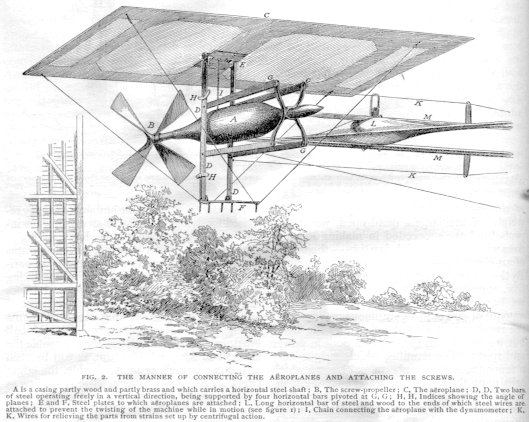Testing Airplane Propellers
Today, we test airplane propellers, 12 years before the Wright brothers flew. The University of Houston's College of Engineering presents this series about the machines that make our civilization run, and the people whose ingenuity created them.
I've just found an astonishing article in the 1891 Century Magazine. The industrialist Hiram Maxim is writing about an apparatus for testing aeroplane propellers. But this was before there were any aeroplanes. Maxim had made a fortune on the Maxim Gun -- the first practical machine-gun which was changing the face of war.
But here his interest is in flight. He begins with a critical look at French attempts to build powered balloons. He thinks they're a clumsy form of flight. Look at birds, he says. A bird weighs 600 times more than the air it displaces. He shows that a goose in flight never exerts more than a tenth of a horsepower.
Heavier-than-air flight is surely the way to go. Yet birds combine lift and propulsion in the wing, and that's too subtle for us to mimic. Maxim knows we'll have to separate the wing from the propeller. So he's built a central tower with a 32-foot rotating arm to measure the effectiveness of propellers and wing surfaces.
A steam engine drives the arm. At the end of the arm is a propeller with a streamlined engine pod and a short section of a wing. That test configuration circles the tower at speeds up to sixty miles per hour, while an electric motor inside the pod drives the propeller.
The apparatus offers means for measuring power input to both the propeller and the rotating arm. Maxim's instruments let him separate out lift, thrust, and drag. He finds that, at sixty miles per hour, the propeller might use sixteen horsepower to lift the wing and another 35 horsepower to overcome drag and its own inefficiency.
With such detailed preliminary work on flight, did Maxim ever fly an aeroplane? Yes, he did. Three years later he built a great steam-powered machine, and one of his people got a few feet off the ground in it. Then it crashed. Maxim had done superb work on the power inventory of flight, but he hadn't solved the crucial problem of controlling a moving aeroplane.
Yet we could use this fine article, from long before the Wright brothers, to build our own propeller test facility. Yesterday, a friend jokingly remarked to me that his visit to Kitty Hawk, North Carolina, had been a disappointment. He'd found himself looking at a research lab -- at test notes, a wind tunnel, and serious experimental and theoretical work. "Shucks," he said, "I thought they just went out and flew the damn thing." Of course they did not. Flight didn't work that way.
I usually go along with the idea that the Wright Brothers were first to fly. Add enough qualifiers and it's true. They achieved repeated, heavier-than-air, controllable flight with a takeoff and a safe landing. But the Wright Brothers had carefully studied all that went before them. Then they added to it. This 1891 article offers just an inkling as to how many people like Maxim and how much work it really took to get us safely into the air.
I'm John Lienhard, at the University of Houston, where we're interested in the way inventive minds work.
(Theme music)
Maxim, H., S., Aërial Navigation: The Power Required. Century Magazine, October, 1891, pp. 829-836.
For a full size image click on a thumbnail above
From left to right, the pictures above are of: (1) the test apparatus, (2) the propeller drive, (3) the propeller and wing test sections, and (4) the steam engine driving the rotor



